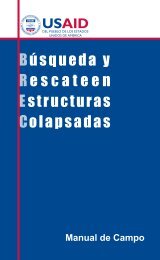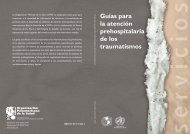Humanitarian Supply Management and Logistics in the Health Sector
Humanitarian Supply Management and Logistics in the Health Sector
Humanitarian Supply Management and Logistics in the Health Sector
Create successful ePaper yourself
Turn your PDF publications into a flip-book with our unique Google optimized e-Paper software.
Chapter 5<br />
Key Characteristics<br />
of Emergency Supplies<br />
What Are Emergency Supplies?<br />
<strong>Humanitarian</strong> or emergency supplies are those goods, materials,<br />
<strong>and</strong> equipment used by organizations to provide relief <strong>in</strong> a disaster,<br />
particularly those required to meet <strong>the</strong> essential needs of<br />
<strong>the</strong> affected population. Such supplies cover an enormous spectrum,<br />
from food, drugs, <strong>and</strong> cloth<strong>in</strong>g to rescue equipment, electric generators,<br />
construction materials, <strong>and</strong> tools.<br />
As noted earlier, <strong>the</strong>se supplies come from many different places. Some<br />
are procured or channeled by organizations <strong>in</strong> response to specific needs<br />
on <strong>the</strong> ground; most, however, are <strong>the</strong> result of <strong>the</strong> spontaneous solidarity<br />
of <strong>the</strong> national <strong>and</strong> <strong>in</strong>ternational community.<br />
From <strong>the</strong> po<strong>in</strong>t of view of <strong>the</strong>ir orig<strong>in</strong>, <strong>the</strong>n, supplies can be of two k<strong>in</strong>ds:<br />
1. Those requested or acquired by organizations based on <strong>the</strong>ir <strong>in</strong>tervention<br />
profiles—medical, economic, reconstructive—<strong>and</strong> on <strong>the</strong><br />
needs of <strong>the</strong> affected population. Regardless of <strong>the</strong>ir relevance, <strong>the</strong>y<br />
are generally managed by <strong>in</strong>stitutions that have asked for <strong>the</strong>m, are<br />
aware of <strong>the</strong> contents of <strong>the</strong> shipments, <strong>and</strong> can assign a specific<br />
recipient for <strong>the</strong> aid.<br />
2. Those supplies that are <strong>the</strong> result of <strong>the</strong> praiseworthy solidarity of<br />
<strong>the</strong> rest of <strong>the</strong> country or <strong>the</strong> world, but which do not necessarily<br />
meet <strong>the</strong> needs faced on <strong>the</strong> ground. They frequently do not have a<br />
specified recipient, <strong>and</strong> <strong>the</strong>ir management is <strong>the</strong> responsibility of<br />
national emergency authorities, who may have to start out by identify<strong>in</strong>g<br />
<strong>the</strong> goods, <strong>the</strong>ir characteristics <strong>and</strong> condition; <strong>the</strong> authorities<br />
must also assign a use—if any—for <strong>the</strong> supplies, select <strong>the</strong> recipients,<br />
<strong>and</strong> coord<strong>in</strong>ate delivery.<br />
Categories<br />
Based on <strong>the</strong> experience of many humanitarian organizations around <strong>the</strong><br />
world <strong>and</strong> <strong>the</strong> thous<strong>and</strong>s of emergencies <strong>the</strong>y have faced, it is generally<br />
35






